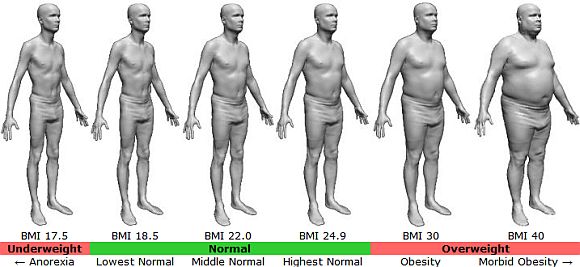 Index
Index

The BMI Calculator calculates the Body Mass Index which is a measure of obesity for adult men and women. The BMI is calculated by dividing the body weight (in kilograms) by the height (in meters) squared (BMI = weight/height2). The BMI will overestimate fatness in people who are muscular or athletic, but fit persons will have a Waist-to-Height ratio less than 0.5, whereas overweight people have Waist-to-Height ratios greater than 0.5.


BMI Calculator for Women, BMI Calculator for Men
BMI is calculated based on the weight and the height of a person.
There is no such thing as a BMI calculator for females or a BMI calculator for males,
but as the pictures show, men and women have different weight distributions.
Men tend to accumulate mass at the waist, whereas women accumulate weight in the hips and buttocks.
The Body Mass Index was invented by Adolphe Quetelet in the first half of the 19th century. Although the index does not measure the percentage of body fat, it is used to estimate a healthy body weight based on a person's height. It is the most widely used metric for identifying individuals with weight problems within a population due to its ease of measurement and calculation.
Information about the images
Several persons have asked whether the images are accurate representations
of the Body Mass Index for actual persons. Professor Brian Curless, who developed
these images, replied:
I would say that these images are "plausible" estimates of body shape as a function of BMI for an individual.
The idea is that we took ~125 scans of women’s bodies and derived correlations between body shape and height and weight across a population (i.e., based on a cross-sectional dataset). We used these correlations to predict how any given scan would look if we were to modify its height and/or weight, or BMI.
I believe the results are at least plausible, because they are derived from detailed, real data, but I cannot argue that they are scientifically validated. For scientific validation, we would need to perform a longitudinal study; i.e., we would have needed to scan an individual before and after she changed her weight, and then see if our algorithm can predict the second scan given only the first scan and the before/after weights. Indeed, we would need to do this for many individuals across a wide range of weight changes for proper validation.
